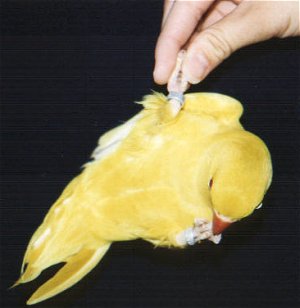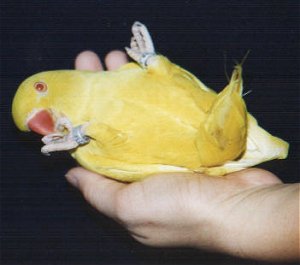They are also what Jaynee calls a "sentinel species," a species which keeps and eye out for danger and notifies other animals if something is out of place. I couldn't agree with her more. Captive ringnecks will call out whenever they sense danger, immediately hushing all other birds in the vicinity. Even my Aussie species know that that call is a warning. My conures can yell all they want and my budgies and tiels will go on about their business. If a ringneck gives the alert they'll all fall silent and look nervously around for the danger. This can be a drawback to breeding the species, as ringnecks must feel safe in order to breed well.
 Noise
Noise
Like a super-loud lovebird, the volume of a conure but a higher pitch. Not a good apartment bird.
Lifespan
Over 30 years.
Sexing
In the green, blue and lutino colors the male will develop a ring at age 18 months to two years. Blue and green males will
get a black ring, lutinos will get a pink ring. Albinos and pieds do not get rings. They also have a distinct breeding
display which can be used to sex the harder mutations.
Weaknesses
Frostbite. Outdoor breeders in colder areas should be aware of this.
Husbandry
Can be housed with other ringnecks and species during the off season, separate pairs for breeding.
Some people have reported successfully colony breeding ringnecks. However, their flights were extremely large so that
territoriality was less of an issue.
Breeding
Pairs do not bond and can be repaired year after year with new mates (pets can also be breeders and pets again). Ringnecks
have an actual breeding season (unlike tiels and budgies). Nestboxes should be put up in the winter. Some pairs will lay as
early as December but may prefer to go to nest in February. Birds will not breed well or at all if uncomfortable with their
surroundings.
 Diet
Diet
These guys are very partial to carrots. Diet is otherwise the same for other psittacines.
Personality/Behavior
This species is matriarchal. That is, the hens rule the roost. Pet owners will find that hens are very good at testing their
limits and pushing their owners. You must use the "Up" command consistently and emphasize the fact that YOU are in control.
Don't let those bossy hens push you around! I'd also recommend keeping this species off your shoulder.
Ringnecks DO make good pets when handfed. It is a common myth that this species is "stand-offish" and has little pet potential. In actuality, ringnecks are very outgoing, clownish birds when properly handfed and socialized. Unfortunately many people still believe the myth and don't even bother to handfeed ringnecks. In 1999 I gave my pet ringneck to my aunt Lin. She had absolutely no luck finding a handfed blue male companion for her. All the breeders she spoke to said the same thing- no one handfeeds ringnecks because they don't make good pets. Eventually she settled for a parent-raised male. Yellow Bird now lives in my aunt's outdoor flight with her mate, still as tame as ever.
